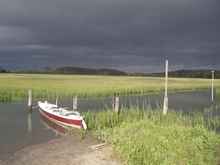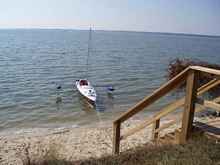Part One - Part Two
After a 1,000+ miles under the keel of the pedal boat Patuxent Queen (PQ), I love my boat and continue to be impressed with the Hobie® MirageDrive® system, but it does come with some quirks. What follows is a description of a typical trip day with follow-on paragraphs next time describing my maintenance and pedaling experiences.
 |
Marsh refuge from unsettled weather. |
Voyaging with the MirageDrive®; One Day’s Experience
The mid-trip day begins with a gentle pedal out of a secluded anchorage. The legs are a little stiff from yesterday's exertion, but a slow cadence works out the kinks and is sufficient to ghost along at a couple of knots. An occasional tweak on the tiller line centers the boat in the gently winding channel, while pedaling otherwise leaves chilled hands free to absorb heat from a cup of coffee. The passage is almost silent. Even the Herons watch without comment. A line of crab buoys provides assurance that the bottom is clear of the fins swinging a foot and a half below the keel. The first gentle swells announce that open water is near and the hull starts to make little splashing sounds as a hint of breeze roughens the water's surface. The pink horizon allows for a study the water's surface for wave patterns betraying the location of sandbars that often inhabit the mouths of Chesapeake Bay inlets. Slow cadence, light pedal pressure and an alertness to quickly flatten the fins against the hull is maintained until well out into the Bay. Preoccupation with water depth is a Darwinian trait of pedal boaters.
The Bay forecast is for 15-20 knots out of the northeast. A few degrees between north and east will determine if the trip north will be an upwind slog or an exhilarating sail. In either case the 12 miles of fetch to starboard ensures it will be rough. When paralleling a lee shore, as on this day, the primary calculus is being far enough out to have time to react to a breakdown (human or mechanical), but close enough to be able to reach shelter quickly, if conditions start to get out of hand. And as a second last resort, an anchor and sea anchor are always at the ready. Today the forecast is accurate and within a couple of hours 3-4 foot, white capped waves march across the Bay. Course is merely a general suggestion, as heading is a continual balance between the risk of getting caught broadside by breakers and the loss of boat speed from meeting waves head on. Since the MirageDrive® provides relatively low acceleration at slow water speeds and even less in head winds, preservation of momentum is essential to making meaningful progress. The 2 knots moving average won't set any records, but it is more than satisfactory considering the conditions. A pod of dolphins magically appears around the boat to lighten the mood. The wind direction (as usual it seems) is right on the edge of being sailable. To sail or not to sail?
 |
PQ with her Balogh sail rig installed. |
Lacking a centerboard or keel, the Queen doesn't point particularly well and the drag of the outriggers and mast precludes pedaling off of a lee shore against a stiff wind. On the other hand, the potential of doubling boat speed with reduced effort is tempting. Ahead, the shore drops away to the west, forming a broad bay and providing sea room to give it a go. The sea anchor holds the boat's stern to the wind (her natural tendency) for the 15 minutes it takes to inflate the amas, raise the mast and bend on the Balogh Batwing® sail. Beating by sail alone results in as much leeway as forward progress, but slow pedaling while sailing pushes boat speed past 4 knots and lifts the bow comfortably upwind of the headland ahead. With increased pressure on the sail and pedals, the entire boat stiffens and begins punching through waves rather than riding over them. Now we're having fun. The ability to "motor sail" is perhaps the greatest performance advantage of the MirageDrive® system.
The remaining miles go by quickly and the day's travels end with a straight run into a narrow inlet, dodging boats fishing the flooding tide. A shallow marsh cove beckons about a half mile in. Before leaving the "marked" (PVC pipes stuck in the mud) channel, the MirageDrive® unit is pulled into the boat and a paddle used for the last hundred yards…and for stopping…and for reverse to set the anchor. Perfect. The cove is small enough for smooth water, but large enough to swing freely at anchor. Even if the anchor drags, all we'll encounter is mud and grass. After a quick inspection, the drive unit is stored in the rear compartment, clearing the pedal well for table space. Supper time…
|







